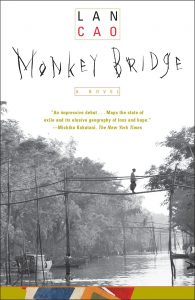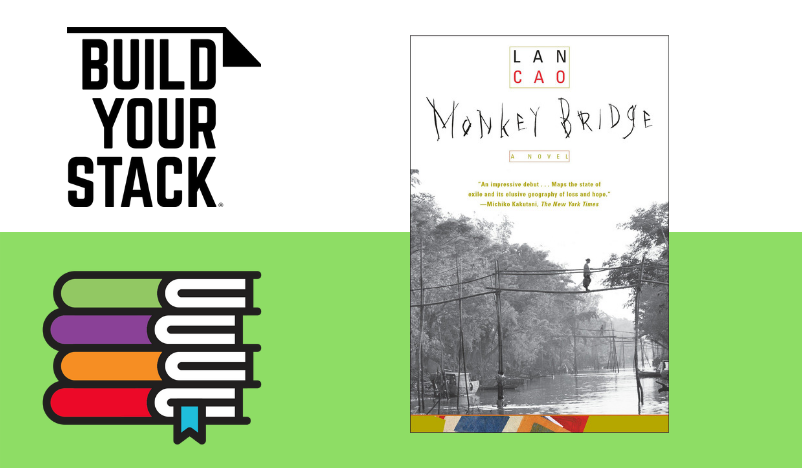This blog post is part of Build Your Stack,® a new initiative focused exclusively on helping teachers build their book knowledge and their classroom libraries. It was written by NCTE member Anna J. Small Roseboro.
As a veteran teacher of over thirty years, I should have known better. But that first year, I was so excited about getting into the book, I forgot to prepare students to get through the book. I just didn’t think about how few contemporary students have the prior knowledge to understand subtleties in a work of historical fiction set in the United States and Vietnam of the 1970s and earlier. I just jumped right in and had to backtrack and start the unit again.
Prior knowledge, you’ll recall, is a combination of the preexisting attitudes, experiences, and knowledge students bring to their reading. We teachers sometimes have to provide that knowledge before teaching a specific piece of literature.
 Monkey Bridge, an autobiographical work, is the first novel by Lan Cao, and it relates the immigration from Vietnam to the United States of a mother and daughter in 1975. The story unfolds as the daughter, Mai, prepares to leave for college. During that year, she reads two journals her mother has written, which provide insight for the daughter and for the readers as well. The first journal describes the mother’s childhood and early years of marriage and takes the reader back to the time when Vietnam was a French colony. The second journal is of her life once she moves from Vietnam to the United States, making her home in Virginia. Because both the times and the places are foreign to most of my West Coast high school students, I realized I needed to do something to expand their knowledge base.
Monkey Bridge, an autobiographical work, is the first novel by Lan Cao, and it relates the immigration from Vietnam to the United States of a mother and daughter in 1975. The story unfolds as the daughter, Mai, prepares to leave for college. During that year, she reads two journals her mother has written, which provide insight for the daughter and for the readers as well. The first journal describes the mother’s childhood and early years of marriage and takes the reader back to the time when Vietnam was a French colony. The second journal is of her life once she moves from Vietnam to the United States, making her home in Virginia. Because both the times and the places are foreign to most of my West Coast high school students, I realized I needed to do something to expand their knowledge base.
Early in the novel, the mother counsels her daughter, “Keep what you see behind your eyes, and save what you think under your tongue. Let your thoughts glow from within. Hide your true self” (41) My students were appalled. They found this advice deceptive. “How,” they wondered, “can a mother give this kind of advice to a child? She’s teaching her to be a phony!” They needed some social context to understand why the mother gives this advice.
This was just one of several social or cultural values and political issues easily explained with a couple of appropriate slides, so I quickly researched and created slides with maps, pictures of clothing, religious and television references, and political and historical issues of the time. I also conferred with the US history teacher, borrowed video, and showed clips from PBS documentaries on US involvement in Vietnam. That first year, I did it all myself.
However, I’ve stopped being the sole provider of background information, realizing how much better it is for students to develop prior knowledge than to be given it.
Today, if I were teaching historical fiction in a school setting with ready access to the Internet, I would plan a two-day in-class assignment for students to do research themselves. I would create prompts to guide pairs/triads or small groups to prepare 3-4 slides each on various topics to show to the class.
Creating their own background knowledge would enhance the study of the book while offering the opportunity to hone myriad other English language arts skills required in that course like research, oral presentation, collaborative learning, and, eventually, critiquing and evaluating texts.
You’ll find your students, too, will have more buy-in to reading when they see how their research fits with that done by their classmates, and they all will better understand the novel when they get to the parts related to their own research.
Here are three ideas to get into, through, and beyond this or other works of historical fiction.
1. GETTING INTO THE BOOK: Researching for Prior Knowledge.
Three-class-period assignment practicing and presenting with low-tech media and visuals. Create a list of key people, places, and events that help shape the historical fiction book you are teaching.
- Class period 1: Small groups research a person, a place, and an event.
- Class period 2: Students create three to five slides to share what they’ve learned in a 6-7 minute presentation during which each member speaks.
- Class period 3: Students share what they learned in their research. (Have groups meet at the start of the class meeting to review their roles and upload their slides on the class computer.)
2. GETTING THROUGH THE BOOK: Connecting to Current Events.
Once students have met the main characters in the historical fiction book you’re teaching, invite them to choose one character and decide what current event that character would be interested in. They should be prepared to explain what they’ve learned about their chosen character and reasons why the current event would interest that character. See a sample assignment here.
3. GETTING BEYOND THE BOOK: Considering Poetry as Response to Historical Fiction.
Reading poetry will help students understand varied responses to the Vietnam War, or to the historical fiction work you’re teaching. See examples from the Poetry Foundation. Set up four groups in which students work together to first read the introductory paragraph for each historical period and then select three poems to share with the class in a 5-6 minute dramatic reading. Or have students write their own individual or group poem in the form of a pantoum to focus on a person, place, or event they’ve learned about in the historical fiction book they’ve just read. Learn more about pantoum poems here.
Have an idea for a Build Your Stack blog post? We’re now accepting submissions from NCTE members! Learn more and submit a post today.

Anna J. Small Roseboro, a National Board Certified Teacher, has over four decades experience teaching in public and private schools, mentoring early career educators, and facilitating leadership institutes. She received Distinguished Service Awards from the California Association of Teachers of English (2009) and the National Council of Teachers of English (2016).

